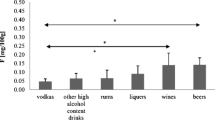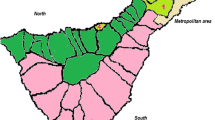Abstract
Fluorine is an element of great importance to human health, as it is considered to be an essential element. However, both a deficiency and an excess, it can cause various problems. It is for this reason that values have been established regarding the recommended daily intake (RDI) and acceptable daily intake (ADI). The largest source of incorporation of fluoride is water, but it can be found in other foods and beverages, such as vegetables, tea, and wine. The aim of the study was to establish the fluoride concentration in organic and non-organic wines from different appellations of origin of the Canary Islands and mainland Spain, in order to assess the contribution of fluoride and toxic risk. A total of 53 samples of red, white, and rosé wines, both organic and non-organic, from different appellations of origin were analyzed. They were analyzed by potentiometric determination with ion-selective electrode for fluoride using the method of standard addition. The wines analyzed are within the recommended limits set by the International Organisation of Vine and Wine. RDI is not exceeded for adults, taking into account the data provided by the Spanish Agency for Consumer Affairs, Food Safety and Nutrition on the average consumption of “table wines” in Spain. Fluoride intake from wine poses no risk to the health of adults. The fluoride concentration of organic and non-organic wines is within the range of 0.03 to 0.70 mg/L.


Similar content being viewed by others
References
Ranjan R, Ranjan A (2015) Fluoride toxicity in animals. Springer briefs in animal sciences. Springer, Cham
World Health Organization (1994) Fluorides and oral health. Report of a WHO expert committee on oral health status and fluoride use. Technical report series, 846. WHO, Geneva
Goschorska M, Gutowska I, Baranowska-Bosiacka I, Rac ME, Chlubek D (2015) Fluoride content in alcoholic drinks. Biol Trace Elem Res 171:468–471
Rodríguez Gómez MI, Hardisson de la Torre A, Burgos Ojeda A, Álvarez Marante R, Díaz-Flores L (2003) Fluoride levels in wines of the Canary Islands (Spain). Eur Food Res Technol 216:145–149
Jáudenes Marrero JR, Hardisson de la Torre A, Gutiérrez Fernández AJ, Rubio Armendáriz C, Revert Gironés C (2015) Evaluación del riesgo tóxico por la presencia de fluoruro en aguas de bebida envasada consumidas en Canarias. Nutr Hosp 32(5):2261–2268
Vitoria Miñana I (1999) Flúor y prevención de caries en la infancia. Acta Pediatr Esp 57:323–328
World Health Organization (2010) Preventing disease through healthy environments, inadequate or excess fluoride: a major public health concern. WHO, Geneva
Perumal E, Paul V, Govindarajan V, Panneerselvam L (2013) A brief review on experimental fluorosis. Toxicol Lett 223:236–251
Barbier O, Arreola-Mendoza L, Del Razo LM (2010) Molecular mechanisms of fluoride toxicity. Chem Biol Interact 188:319–333
Gutiérrez-Salinas J, Hernández-Rodríguez S, Carmona-García R, Cerón-Arteaga TJ, Cruz-Gómez J, Olivares-Báez A, Lozada-Medina IF, Zepeda-García C, Verdejo-Malagón I (2011) Efecto del fluoruro de sodio sobre enzimas antioxidantes en el eritrocito humano. Rev Mex Patol Clin 58(4):215–220
Irigoyen-Camacho ME, García Pérez A, Mejía González A, Huizar Álvarez R (2016) Nutritional status and dental fluorosis among schoolchildren in communities with different drinking water fluoride concentrations in a central region in Mexico. Sci Total Environ 541:512–519
Tressaud A, Haufe G (2008) Fluorine and health. Molecular imaging, biomedical materials and pharmaceuticals. Elsevier, Amsterdam
Martínez-Mier EA, Shone DB, Buckley CM, Ando M, Lippert F, Soto-Rojas AE (2016) Relationship between enamel fluorosis severity and fluoride content. J Dent 46:42–46
Fordyce FM (2011) Fluorine: human health risks. In: Nriagu J (ed) Encyclopedia of environmental health. Elsevier, Burlington, pp. 776–785
Fordyce FM, Vrana K, Zhovinsky E, Povoroznuk V, Toth G, Hope BC, Iljinsky U, Baker J (2007) A health risk assessment for fluoride in Central Europe. Environ Geochem Health 29:83–102
Soriano M (1972) Sobre la historia médica de la fluorosis. An Med Cir 52(227):17–21
Orden Ministerial del 31 de julio de 1977. Método oficial español de análisis de fluoruro en vinos. BOE, España
Martín M, Hardisson A, Espino M, Álvarez R (1990) Determinación potenciométrica de fluoruro en aguas de bebidas envasadas. An Real Acad Farm 4:569–576
Perez Olmos R, Hardisson A, Elias M, Rios R, Martin M (1990) Determination of fluoride in Tenerife wines. Comparative study of conditioning solutions. Belg J Food Chem Biotechnol 45(6):208–213
Pérez-Olmos R, Herrero R, Lima JLFC, Lopes TIMS, Rangel AOSS (1995) Bibliographic study of potentiometric methods of wine and must analysis. J Int Sci Vigne Vin 29(3):159–169
Rodríguez Gómez MI (2015) Determinación potenciométrica de la concentración de fluoruros en aguas y en algunos alimentos líquidos. Cálculo de la ingesta por parte de la población canaria. Tesis Doctoral, Universidad de La Laguna
Bernal JL, Del Nozal MJ, Pardo R (1979) Determinación de fluoruros en vinos. Rev Agroquim Tecnol Aliment 19(4):541–548
De Baenst G, Mertens J, Vandenwinker P (1973) Détermination de l’ion fluorure dans le vin, par potentiométrie. J Pharm Belg 28(2):188–194
Deschreider A, Meaux R (1974) Détermination du fluor dans les vins et les eaux minérals naturelles au moyen d’une électrode ionique spécifique. Rev Ferment Ind Aliment 28:150–156
Hardisson A (1996) Proyecto de investigación de la Consejería de Sanidad y Consumo titulado “Estudio de las concentraciones de fluoruro en aguas y vinos de las Islas Canarias. Evaluación de los efectos toxicológicos de su consumo”. Resolución de 26 de agosto de 1996. Boletín Oficial de Canarias (Miércoles, 18 de septiembre de 1996) 119:8619–8623
Martínez Rincón MC, Abuín Cabeza LM (1990) Flúor en vinos de denominación de origen méntrida. An R Acad Farm 56:279–282
Hidalgo JL, Pastor M, Pérez-Bustamante JA (1983) Determinación de fluoruro en vinos del Marco de Jerez. Anal Bromatol 35:67–77
Martin C, Brun S (1969) Le dosage du fluor dans les vins. Trav Soc Pharm de Montpellier 29(3):161–167
Moreno F, De la Torre MC, Serrat M (1971) Un electrodo específico para la determinación de pequeñas cantidades de ion fluoruro. Circ Farm 29:315–331
Cuervo M, Corbalán M, Baladía E, Cabrerizo L, Formiguera X, Iglesias C, Lorenzo H, Polanco I, Quiles J, Romero de Ávila MD, Russolillo G, Villarino A, Martínez JA (2009) Comparativa de las Ingestas Dietéticas de Referencia (IDR) de los diferentes países de la Unión Europea, de Estados Unidos (EEUU) y de la Organización Mundial de la Salud (OMS). Nutr Hosp 24(4):384–414
EFSA Panel on Dietetic Products, Nutrition, and Allergies (NDA) (2013) Scientific opinion on dietary reference values for fluoride. EFSA J 11(8):3332
Standing Committee on the Scientific Evaluation of Dietary Reference Intakes (1997) Food and Nutrition Board of the Institute of Medicine of the National Academies. Dietary reference intakes for calcium, phosphorus, magnesium, vitamin D and fluoride. National Academy Press (US), Washington (DC)
Agencia Española de Seguridad Alimentaria (2006) Modelo de dieta española para la determinación de la exposición del consumidor a sustancias químicas. Ministerio de Sanidad y Consumo, España
González Sacramento N, Rubio Armendáriz C, Gutiérrez Fernández AJ, Luis González G, Hardisson de la Torre A, Revert Girones C (2015) El agua de consumo como fuente de exposición crónica a fluoruro en Tenerife; evaluación del riesgo. Nutr Hosp 31(4):1787–1794
Author information
Authors and Affiliations
Corresponding author
Ethics declarations
Conflict of Interest
The authors declare that they have no conflict of interest.
Rights and permissions
About this article
Cite this article
Paz, S., Jaudenes, J.R., Gutiérrez, A.J. et al. Determination of Fluoride in Organic and Non-organic Wines. Biol Trace Elem Res 178, 153–159 (2017). https://doi.org/10.1007/s12011-016-0910-1
Received:
Accepted:
Published:
Issue Date:
DOI: https://doi.org/10.1007/s12011-016-0910-1




